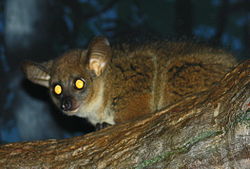Strepsirrhini
The Strepsirrhini clade is one of the two suborders of primates, with 114 species. They are defined by their wet noses, although the Greek name means having a curved or bent nose. Madagascar's only primates (apart from humans) are strepsirrhines, although others can be found in southeast Asia. Their eyes have a reflective layer to improve their night vision called a tapetum lucidum, and their eye sockets have a ring of bone around the eye called a post-orbital bar.[1] Strepsirrhine primates produce their own vitamin C, whereas haplorhine primates (including humans) must get it from their diets.
| Strepsirrhini Temporal range: Early Eocene - Recent
| |
|---|---|
| Coquerel's Sifaka (Propithecus verreauxi) | |
| Scientific classification | |
| Kingdom: | |
| Phylum: | |
| Class: | |
| Order: | |
| Suborder: | Strepsirrhini E. Geoffroy, 1812
|
The suborder contains the lemurs and lorises. The modern types probably evolved from the Adapiforms, an extinct group.
The origin of the earliest primates, from which both the strepsirrhines and haplorhines (simians and tarsiers) evolved, is a mystery. Both their place of origin and the group from which they evolved are uncertain.
Although the fossil record of their initial radiation across the Northern Hemisphere is very detailed,[2] the fossil record from the tropics—where primates most likely evolved—is very poor, particularly around the time that primates and other eutherian mammals were first appearing.
So, geneticists and primatologists have used genetic analyses to determine the relatedness between primate lines and when they diverged. Using this molecular clock, it seems that primates evolved more than 80–90 million years ago, nearly 40 million years before the first primates appear in the fossil record.[3]p22[4]
Classification
- Suborder Strepsirrhini: non-tarsier prosimians
- Infraorder Lemuriformes
- Superfamily Lemuroidea
- Family Cheirogaleidae: dwarf and mouse lemurs (32 species)
- Family Daubentoniidae: Aye-aye (1 species)
- Family Lemuridae: lemurs (22 species)
- Family Lepilemuridae: sportive lemurs (26 species)
- Family Indriidae: woolly lemurs and allies (19 species)
- Superfamily Lorisoidea
- Superfamily Lemuroidea
- Infraorder Lemuriformes
Strepsirrhini Media
Early primates possessed adaptations for arboreal locomotion that enabled maneuvering along fine branches, as seen in this slender loris.
Notharctus, a type of North American adapiform, resembled lemurs but did not give rise to them.
The suborder Strepsirrhini was proposed by É. Geoffroy in 1812.
The media attention over "Ida" played upon confused terminology and misconceptions about strepsirrhines.
Strepsirrhines have a reflective layer in the eye, called a tapetum lucidum, that helps them see better at night.
Strepsirrhines are characterized by a typically longer snout and wet nose compared to haplorhine primates.
Strepsirrhines are threatened by deforestation in tropical regions.
References
- ↑ Scott McGraw, W. (2023-03-08), Larsen, Clark Spencer (ed.), "Primates Defined", A Companion to Biological Anthropology (1 ed.), Wiley, pp. 277–299, doi:10.1002/9781119828075.ch17, ISBN 978-1-119-82804-4, retrieved 2024-02-09
- ↑ Rose K.D. 2006. The beginning of the age of mammals. Johns Hopkins University Press, 168/9. ISBN 978-0-8018-8472-6
- ↑ Hartwig, W.C. (ed) 2002. The primate fossil record. Cambridge University Press, pages 13–20 [1], 21–44 [2], 133–149 [3]. ISBN 978-0-521-66315-1
- ↑ Field Museum, Chicago. Scientists push back primate origins from 65 million to 85 million years ago. Science Daily. [4]







